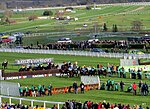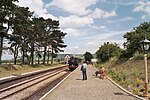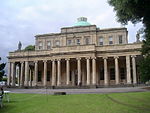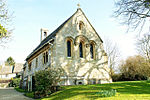Cheltenham Festival

The Cheltenham Festival is a horse racing-based meeting in the National Hunt racing calendar in the United Kingdom, with race prize money second only to the Grand National. The four-day festival takes place annually in March at Cheltenham Racecourse in Cheltenham, Gloucestershire. It usually coincides with Saint Patrick's Day and is particularly popular with Irish visitors.The meeting features several Grade I races including the Cheltenham Gold Cup, Champion Hurdle, Queen Mother Champion Chase and Stayers' Hurdle. Large amounts of money are gambled; hundreds of millions of pounds are bet over the course of the week. Cheltenham is noted for its atmosphere, including the "Cheltenham roar", which refers to the enormous amount of noise that the crowd generates as the starter raises the tape for the first race of the festival.
Excerpt from the Wikipedia article Cheltenham Festival (License: CC BY-SA 3.0, Authors, Images).Cheltenham Festival
Apple Orchard,
Geographical coordinates (GPS) Address Nearby Places Show on map
Geographical coordinates (GPS)
| Latitude | Longitude |
|---|---|
| N 51.920277777778 ° | E -2.0577777777778 ° |
Address
Cheltenham Racecourse
Apple Orchard
GL52 3EB , Prestbury
England, United Kingdom
Open on Google Maps






